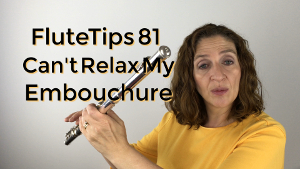Do you know that a tight embouchure is not what will give you the best tone? I think most of us know that is not the way to play. But I have experienced that students don’t know what a tight embouchure actually means and have no idea how to loosen that embouchure.
Probably 90% of the students that come to take lessons from me, whether in high school, or college, or adults all play with an embouchure that is much too tight. It’s the very rare occasion where a student comes to me with a beautifully relaxed embouchure. I can always tell because their tone reflects that relaxed embouchure. It is amazing how much the tone can change for the better when the embouchure is set properly.
A wonderful side benefit of a relaxed embouchure is that it is much easier to play, and you feel better playing.
When I was in high school I mistakenly thought that my embouchure was set and that wasn’t going to change. My misguided ideas were that to get a better tone I needed to just play more or have a better flute. Little did I know that an embouchure is something that can move and change and be oh-so-flexible. So much for being “set!”
How do you go about changing it?
There are 2 things necessary: the mirror, it is your best friend and you’ve got to do little bits of practice all throughout the day, not just one big practice session. Changing your embouchure is a big thing. Any change you want to implement is countermanded by the years of playing with the old embouchure. Every time you try to change it wants to go back and do what it’s been doing for however many years you’ve been playing. That’s why you need the mirror.
When you have lessons your teacher will tell you what you need to do and remind you when it’s not being done. Now you are at home trying to remember and do what was asked of you. When it comes to an embouchure change there is no way you can feel the change. You must look in the mirror to see what you are doing. The mirror stands in place of the teacher.
What does a relaxed embouchure look like? Well it looks like you. Yes you. Look at your mouth when it is relaxed and natural with the lips closed. When you play flute you want to look pretty much like that.
When the flute comes up to the lip the embouchure should as close to that natural look as possible. This is where the mirror comes in. You must look at yourself or else you will go right back to what you used to do. From this relaxed position you lower your jaw, open up, and play.
For a person who’s got a tight embouchure, it’s going to take a lot of work. But little bits of frequent practice is where its at. If you can do 4 or 5 practice sessions throughout the day for a week straight really you will learn what that relaxed embouchure can do. Sometimes you will feel like you have taken a step backward. Think of this as a little step backward to take a giant step forward.
Watch your embouchure. When I tell students to do this, almost every time they close right back up to their old embouchure when they begin to play. The minute they put their flute up and they take their breath, it goes right back up and tight. This is where practicing in short bits works best. If that is what is happening to you, you have to play short bits.
Here is what you should do:
Put the flute up to your lip.
Move the jaw down
Open the lips
Take a breath and play a short tone.
Pull the flute away.
Repeat
Do not play long notes just short tones. With longer notes your embouchure will go back to what its used to.
NO Solos
NO Etudes
This type of practice can get frustrating. So, that’s why it’s just little bits of practice. You have to put away all the music you’ve been playing. You can’t play your etudes and your solos. Practice little tonguing bits with staccato. Staccato really helps to make sure that you are forcing your embouchure to get tone out right away. And let me tell you, when you’re working on that, it’s just fine for just puffs of air to come out.
Changing an embouchure and making it more relaxed is can be monumental. You need to take an entire week where you’re doing nothing but little bits of practice. Staccato with scales. Your Taffanel and Gaubert #1 and 2 or ideally #8. Bit by bit and you can change that embouchure. Anybody can. You’ll be happy that you did because a relaxed embouchure is open and has a cleaner sound.
Try this. Don’t get frustrated. Let me know if you want some extra help. I’d be happy to give you some advice.
Have fun!
DoctorFlute
Watch me demonstrate this: FluteTips 81 I Can’t Relax My Embouchure

Tight Embouchure No Problem – FluteTips 182

How to Form a Great Flute Embouchure – FluteTips 132

FluteTips 10 Relaxed Embouchure Improves Tone

